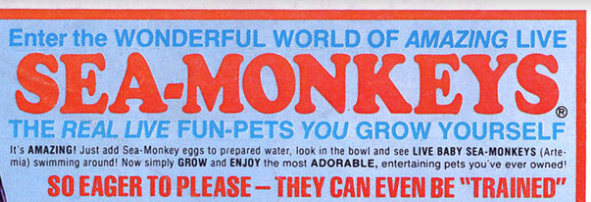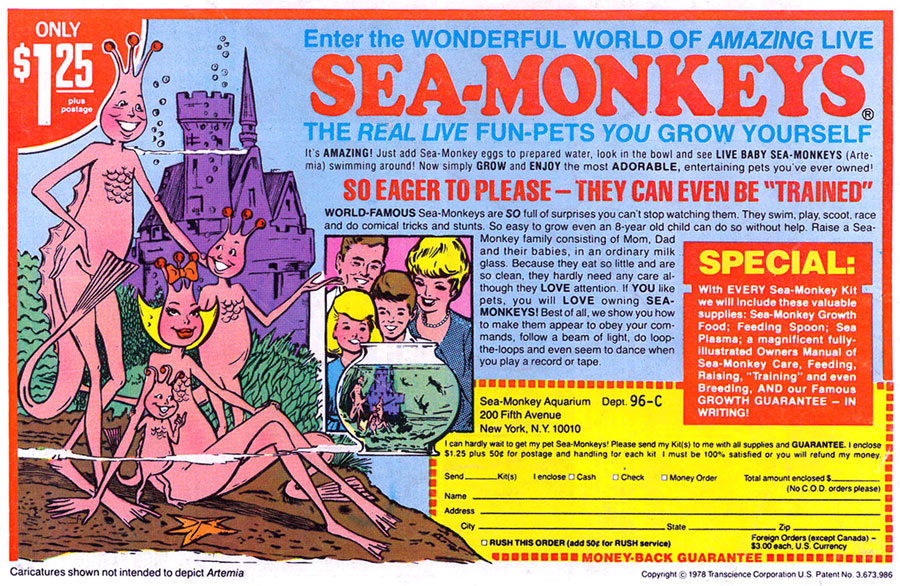What I learned from Buying Sea Monkeys

Children as Consumers
When a baby is born, that little bundle of joy represents a lifetime of love and hope for parents. From 0 to sometime in their 20s, that sweet little brain works hard to fuse and form and become a powerful decision-making machine.
Corporations see that sweet baby as an opportunity – a new consumer being born into a world saturated by inducements to spend. As a parent, it is your job to stay ahead of that advertising curve and keep your little angels one step ahead of the corporations. They might live and die by their bottom line, but your bottom line is the well-being of your child.
You can absolutely teach your kids to resist advertising, avoid peer pressure and become smart consumers and manage finances.
Advertising that targets our kids is insidious. It’s all around us, in apps, games, tv shows, billboards, cereal boxes, clothes, and in school.
Helping our kids to recognize that companies are trying to get them to spend their money with ads on goods and services is one thing. But helping them realize that the things companies are selling may not be as fantastic as the ads portray them is even more important.
How can we teach our kids to research and discern the difference between real quality products and hype?
There are 5 things we can do to help our kids to resist ads and become savvy consumer kids.:
- Research: the best tool for any consumer.
- Math: your opportunity to prove school isn’t a total waste of time.
- Patience: kids can be patient when they really want something.
- Goal-setting: the foundation of a successful life.
- Failure is Okay: small childhood failures prevent bigger ones as adults.
Keep reading to get the details.
The Goal of Advertising
Here is the only truth you need to know in advertising – you are being manipulated to spend money. Period. End of story.
Someone is going to tell you the things you want to hear, show you images that make you feel a certain way, and suddenly you can’t wait to shove your hard-earned money at someone for the promise of “fill in the blank.”
We know advertising works on us as adults – just look at how much money is spent on Super Bowl Ads, Facebook Ads, Google Ads, Billboards, Bus Ads, and the list goes on and on.
If we have become susceptible to the advertisers’ pitches, imagine how this deluge of promotions affects our kids. There are pronounced effects of advertising to youth.
What Can A Parent Do to Shield Children from Ads?
We, as parents, can prepare our kids to protect what they earn and not get fooled by false advertising. Perhaps the best way to teach your kids is to allow them to experience disappointment.
Related Article: Best Books To Teach Young Children About Money
What I Learned About Advertising with Sea Monkeys
I became a skeptical, patient buyer that does research because of the great Sea Monkey debacle of 1985.
Perhaps it was naiveté, perhaps it was the Aqua Net all around me that fogged my brain, but I lost $16 of hard-earned money because I believed I was purchasing a “bowlful of happiness.”
5 Easy Ways to Help Your Kids Become Smart Consumers
Before I tell you about my childhood failure, here are 5 ways you can help your child become a smart consumer.
1. Smart Consumers Do Research
The great news is that there is more information available to the consumer than there ever was in 1985. If I had been able to Google Sea Monkeys back in the day, my heartbreak could have been spared.
The first thing to teach your child is that every purchase should be researched. The best place to conduct research is Amazon. Amazon carries the vast majority of products children want, and inevitably there are thousands of parents who have documented their child’s unadulterated joy or unconsolable disappointment with the item.
Taking the time to go through reviews and discuss them with your child will teach them excellent lessons:
Some things are actually too good to be true. There is always that one item that is priced 50% below the others but looks exactly the same. Generally speaking, that item will be terrible and the reviews will detail shoddy craftsmanship, cheap materials, and fraudulent branding.
This is a great opportunity to teach your child that things are not always as they appear. This lesson has broader applications for life but is even isolated to consumer products, it’s worth learning.
Nothing is perfect. There are very few perfect 5-star items on Amazon. If we reserved our purchases for only things that scored a perfect 5 stars, we would save ourselves a lot of money. This exercise in reading reviews will teach your child that there are always issues and tradeoffs with products.
- Maybe one is prettier, but it breaks more easily.
- One could be more sturdy, but the assembly time could be prohibitive.
- One could look like the most fun but only work under perfect circumstances.
These are all lessons we can learn from reviews, instead of trial and error. Again, this lesson has broader implications for life and learning to prioritize qualities and make trade-offs is good for children.
2. Smart Consumers Do Math
Kids complain about having to learn…well, anything. But they particularly seem to complain about math. This is a golden opportunity to show your kids just how useful it is to be able to do some quick and simple calculations.
- Some items will include shipping, and some will not.
- This is an excellent opportunity to debunk the fallacy of “free shipping.”
- Things are not free – they are simply built into the cost.
- Some items will come with accessories, and some will not.
- If you’re shopping for treats, some bags will come with more individually wrapped items, while others will have greater weight or quantity inside the wrappers.
All of this will require your child to do some simple math to determine the best deal, and maybe it will result in a little less whining the next time the homework includes multiplication.
3. Smart Consumers Practice Patience
One of the key ways advertisers get to us is by convincing us to make an emotional decision, right now. This is a golden opportunity to instill a good habit in your child. If you don’t need to decide now, don’t.
Do a little research, analyze the true cost, and then just walk away and think about it for a while. Kids can be difficult because they’re emotional, but this also can work in your favor.
One day Johnny wants legos, the next he wants a slingshot. Encourage your child to take a break and come back to the purchase a little later, when they’re sure.
Set an amount of time that works for your family – one day is a good rule of thumb. Half the time your child will have moved on and learned a valuable lesson.
4. Smart Consumers Do Goal Setting
Not all purchases are bad. Childhood wants are an ideal opportunity to teach children how to set a goal and save.
“Success is the progressive realization of a worthy goal or ideal.” —Earl Nightingale
Goal-setting gives children a sense of purpose and motivates them to achieve. Any parent who has watched their “bored” child hang off couches complaining “there’s nothing to do” knows the importance of motivation.
Everyone needs something to achieve. If your child is taken in by an Ad and wants something so badly they are willing to work for it, seize the opportunity. We developed an App that will take a picture of what they want and break it into puzzle pieces they can earn one at a time.
There is the analog way of just putting a piece of paper on the refrigerator and paying them for chores and watching the money add up over time. However, you track their progress, showing them visually that they are making progress is key.
Make sure the goal is achievable and age-appropriate (a 3-5-year-old should be able to earn it in a day, while a 10-12-year-old could take over a week). Encourage your child every day and remind them to be proud of each incremental win.
Never forget:
“Achievement and depression are inversely related.”
Dr. Jennifer Gatt, Ph.D., Advising Board Member, My First Nest Egg
5. Smart Consumers Use Failure as a Lesson
We spend a lot of time reminding ourselves that literally, everyone fails.
“Don’t fear failure. Fear the absence of progress.” Someone super smart.
Kids absolutely need to know that they will make mistakes and that is 100% okay. It’s good. Mistakes are nothing more than necessary opportunities to learn, grow, and improve.
Our adult successes are built on childhood failures. No matter how many times you tell your child that the object of their desire isn’t what it seems, they might just not believe you.
Let them earn, save and buy whatever it is, and learn themselves. We cannot rob children of all opportunities to make mistakes for themselves just because it’s painful for us to watch. They deserve to struggle with mistakes, internalize the lessons, and come out on the other side stronger, smarter, and determined to not repeat.
One Mistake = A Lifetime of Skepticism
And that brings me to the Sea Monkeys. (Spoiler Alert: there are no such things.)
Now that you know the things you should be teaching your children so that they can become successful consumers, here’s my story. See how many of these principles I violated.
My Not So Smart Consumer Story
Here’s how the Sea Monkey saga went down:
I was seven years old. I had curly bangs (not a good look) and I read comic books (I can’t remember which ones, but I got new ones each month).
And each month, I would flip to the back of the magazine to study the Sea Monkey ad and the promise of new little friends.

I asked my parents for Sea Monkeys.
They said no. But I said, “then I will buy them with my own money.”
My dad insisted that there are no such things as tiny underwater monkeys, but I knew better.
What My Child Eyes Beheld
I had seen the cartoon depiction of an active aquatic monkey family. The ads made them look happy. They played beach volleyball with tiny plastic balls.
My dad told me that for twenty cents he could get me a bowl full of brine shrimp. But I knew better – Sea Monkeys are much more fun than Brine Shrimp!
What I Did to Earn My Sea Monkeys
I did my chores. I picked up dog poop for a neighbor for extra cash. I even raided my plastic piggy bank (which was a no, no in my house) by shaking coins from the top hole.
I happily parted with the $3 for the Sea Monkeys. They needed a home, so I bought a small fish tank. And I wanted them to be happy, so I purchased a tiny castle and some landscaping.
And finally, because I wanted them to live a long life, I also bought a bubbler. At this point, I was in $16.
RELATED ARTICLE: Successful Alternatives to Behavior Charts
My Advertising Awakening
My Sea Monkeys arrived after a month of waiting – there was no Amazon next day delivery back then.
They came in a tiny envelope. The picture from the ad of a happy family could not have fit in the small envelope.
But I was undeterred. I knew I was going to realize my dream of being the owner of happy Sea Monkeys.
I followed the instructions and dropped the Sea Monkey pellet into the water.
I said my prayers, and went to sleep, knowing that in the morning, my parents would be proved wrong and my sea monkey friends would be there to greet me. I would bring my parents into my room and let my new friends wave at them. Perhaps I’d let my parents let them watch one of their volleyball games. I would be a gracious winner.
I Woke Up to Reality
I woke up to a bowl full of brine shrimp. It looked like diarrhea in a bowl. It smelled like rotting seaweed.
There were no tiny monkeys.
Perhaps they needed more time to grow, I thought, or more oxygen.
So, I put the bubbler hose in the tank and went to eat breakfast.
At breakfast, it was a game of chicken.
I would not admit defeat. My dad giggled a few times. But we had no real conversation.
I went to school and when I got home, I rushed into my room to find a huge surprise. Not only had my Sea Monkeys not developed into a magical colony of gilled primates, but the bubbler had blown all of the brine shrimp to the edges of the glass bowl where they perished in a smelly plastered heap.
My dad helped me scrub down the bowl. While he definitely said, “I told you so,” he didn’t try to make me feel stupid. I knew that he understood the defeats of childhood and was there to help me scrub through them.
I really learned two lessons that day: ads can be lies and my dad would always be there for me. It stung, but in hindsight, it was well worth the $16.
The Lesson Was Learned
It’s also important to note what my dad did not do. He did not give me back a dime of the money I lost.
When we visited family a few weeks later and walked into a toy shop, my brother had $10 to spend.
I had only saved up another $2 since my Sea Monkey expenditure.
I was sad and disappointed watching my brother buy fun treats that I wanted.
So I left the cool toy shop with no trinkets, but with a lesson learned. This silly event changed the way I shopped for a lifetime.
Conclusion
So the next time your kids are watching commercials and beg and plead for a toy you know will disappoint them, don’t say no.
Go through steps 1-4 and do your best to instill the lessons that will make them smart consumers for life. But, when you’ve exhausted your cautionary tales, move on to lesson 5.
Let them spend their own money. Let them feel disappointed or rewarded for their own choice and investment.
Give your kids the chance to fail in small ways now.
My husband and I cherish our kids’ small failures. There is no safer place to learn disappointment than while your kids are at home with you.
Don’t let them get to college where the first mail they will receive is a high-interest rate credit card and no skepticism. Smart “kidsumers” will turn into smart consumers, and that is a win everyone (except corporations) will enjoy.
